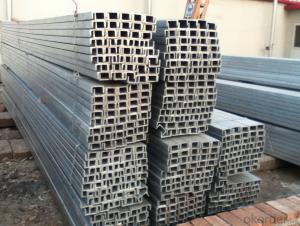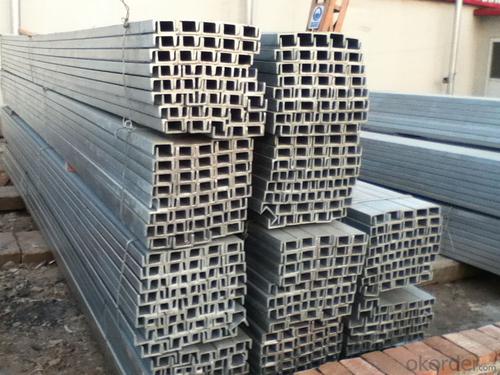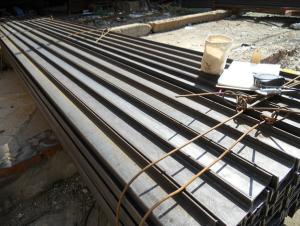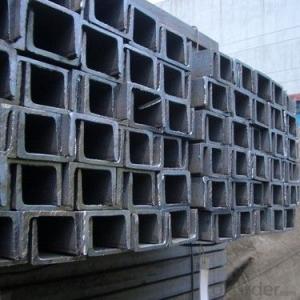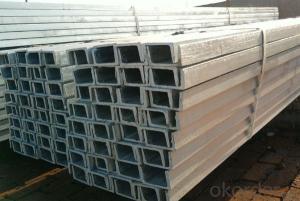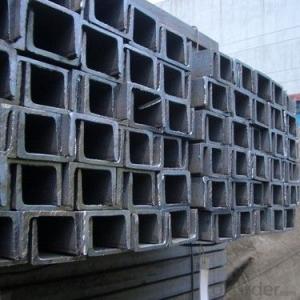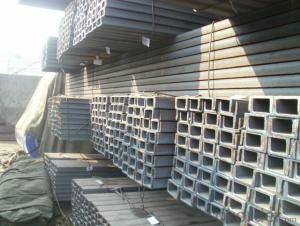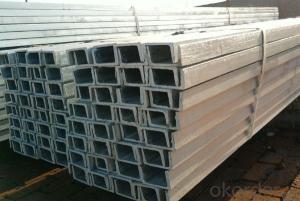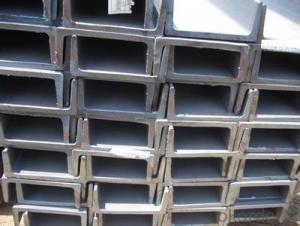High quality channel for JIS and GB standard
- Loading Port:
- Tianjin
- Payment Terms:
- TT OR LC
- Min Order Qty:
- 25 m.t.
- Supply Capability:
- 20000000 m.t./month
OKorder Service Pledge
OKorder Financial Service
You Might Also Like
Product Description:
Product Description:
Specifications of MS Channel:
1.We supply high quality MS Channel at reasonable price, including Chinese standard, Japanese standard and so on.
Standard | GB/JIS |
Material Grade | Q235,SS400 |
Technique: | Hot Rolled |
Sizes as per chinese standard: | 50*37*4.5mm - 300*89*11.5mm |
Sizes as per japanese standard: | 50*25*3mm – 200*80*7.5mm |
Length: | 6meter, 9meter, 12meter |
Note: 1.we are also competent to provide our customers other MS Channel based on other sizes according to customer’s requirements.
2. The length of our ms channel could be cut into other meters as per customer’s requirements. For example, the channel in 6meters could be cut into 5.8meters in order to be fit in the 20ft container.
2. The detailed sections of MS Channel as per GB standard.are shown in the table-1:
GB U CHANNEL | Standard | Sectional | Dimension |
| Mass: |
(mm) | (mm) | (mm) | (mm) | ||
50X37 | 50 | 37 | 4.50 | 7.0 | 5.438 |
63X40 | 63 | 40 | 4.80 | 7.5 | 6.634 |
80x43 | 80 | 43 | 5.00 | 8.0 | 8.045 |
100x48 | 100 | 48 | 5.30 | 8.5 | 10.007 |
120x53 | 120 | 53 | 5.50 | 9.0 | 12.059 |
140x58 | 140 | 58 | 6.00 | 9.5 | 14.535 |
140x60 | 140 | 60 | 8.00 | 9.5 | 16.733 |
160x63 | 160 | 63 | 6.50 | 10.0 | 17.240 |
160x65 | 160 | 65 | 8.50 | 10.0 | 19.752 |
180x68 | 180 | 68 | 7.00 | 10.5 | 20.174 |
180x70 | 180 | 70 | 9.00 | 10.5 | 23.000 |
200x73 | 200 | 73 | 7.00 | 11.0 | 22.637 |
200x75 | 200 | 75 | 9.00 | 11.0 | 25.777 |
220x77 | 220 | 77 | 7.00 | 11.5 | 24.999 |
220x79 | 220 | 79 | 9.00 | 11.5 | 28.453 |
250x78 | 250 | 78 | 7.00 | 12.0 | 27.410 |
250x80 | 250 | 80 | 9.00 | 12.0 | 31.335 |
250x82 | 250 | 82 | 11.00 | 12.0 | 35.260 |
280x82 | 280 | 82 | 7.50 | 12.5 | 31.427 |
280x84 | 280 | 84 | 9.50 | 12.5 | 35.823 |
280x86 | 280 | 86 | 11.50 | 12.5 | 40.219 |
300x85 | 300 | 85 | 7.50 | 13.5 | 34.463 |
300x87 | 300 | 87 | 9.50 | 13.5 | 39.173 |
300x89 | 300 | 89 | 11.50 | 13.5 | 43.883 |
Table-1
3. The chemical composition of HR Channel Steel according to Q235B is shown in Table-2.
Alloy No | Grade | Element(%) | ||||
C | Mn | S | P | Si | ||
Q235 | B | 0.12-0.20 | 0.3-0.7 | ≦0.045 | ≦0.045 | ≦0.3 |
Table-2
Note: we are able to present our customers relevant SGS test report for chemical composition of HR Channel Steel.
4. The mechanical property of HR Channel Steel according to Q235B is shown in Table-3-1 and Table-3-2
Alloy No | Grade | Yielding Strength Point(Mpa) | |||
Thickness(mm) | |||||
≦16 | >16-40 | >40-60 | >60-100 | ||
≧ | |||||
Q235 | B | 235 | 225 | 215 | 205 |
Table-3-1
Alloy No | Grade | Tensile Strength(Mpa) | Elongation After Fracture(%) | |||
Thickness(mm) | ||||||
≦16 | >16-40 | >40-60 | >60-100 | |||
≧ | ||||||
G235 | B | 375-500 | 26 | 25 | 24 | 23 |
Table-3-2
Note: we are able to present our customers relevant SGS test report for mechanical property of MS Channel as customer’s request.
Applications of MS Channel:
The MS Channel can be applied to construction of warehouses, workshops, sport stadiums and car parks etc.The hot rolled channel steel belongs to carbon structural steel which is applied to in the field of construction and machinery.In details, the hot rolled channel steel is usually used for arch-itechtural structure, and they could be welded in order to support or hang a vari-ety of facilities. They are also usually used in combination with I beam. Generally,the hot rolled channel steel we supply must possess perfect welding property, riveting property and mechanical property and so on.
Package & Delivery of MS Channel:
1.The hot rolled channel steel will be packed in bundle with steel wire at each end of every bundle and color marking in order to help the customer to recognize his goods more easily at sight.
2. And the hot rolled channel steel could be loaded into 20ft or 40ft container, or by bulk cargo.If the weight of each bundle reaches more than 3.5 mt, the loading by break bulk cargo should be choosed.When the weight of each bundle reaches less than 3mt, the loading by container should be choosed.
3.As for the transportaion from mill to loading port, the truck will be usually used. And the maximum quantity for each truck is 40mt.
4.All in all, we could do in accordance with customer's request
- Q: Does anyone know how to calculate the volume of channel steel?!
- Theoretical calculations can be used: sectional area * length. There are sectional sizes in the specifications of channel steel labels. The sectional area and volume shall be calculated first. When measuring the sectional area, the grid paper can be used. Of course, the accuracy is limited.
- Q: Channel
- At the same height, the light channel steel has narrower legs, thinner waist and lighter weight than ordinary channel steel. 18 - 40 is large channel steel, 5 - 16 channel steel is medium channel steel. Imported channel steel shall be marked with actual specifications, sizes and relevant standards. Steel import and export orders generally is identified in the corresponding (carbon steel or low-alloy steel), to use the required specifications. Except for specification, channel steel has no specific composition and performance series
- Q: What are the different surface treatments available for steel channels?
- Some of the different surface treatments available for steel channels include galvanizing, powder coating, painting, and epoxy coating. Galvanizing involves applying a protective layer of zinc to the surface of the steel, providing corrosion resistance. Powder coating involves applying a dry powder to the surface of the steel, which is then heated and cured to create a durable and decorative coating. Painting involves applying liquid paint to the steel surface, providing both protection and aesthetics. Epoxy coating involves applying an epoxy resin to the steel surface, which creates a durable and chemically resistant coating.
- Q: Can steel channels be used in telecommunications towers?
- Steel channels are indeed applicable in telecommunications towers. Their strength, durability, and versatility enable a range of uses. In terms of structural support, steel channels provide stability and the ability to bear heavy loads for the tower. By fabricating and assembling the channels, they form the framework of the tower, allowing for the installation of diverse equipment like antennas, transmitters, and receivers. Moreover, the design of steel channels allows for seamless integration of cables and wiring, thereby facilitating efficient connectivity throughout the tower. Ultimately, the incorporation of steel channels in telecommunications towers guarantees a robust and dependable infrastructure for effective communication networks.
- Q: How are steel channels used in the construction of hospitals or healthcare facilities?
- Steel channels are used in the construction of hospitals or healthcare facilities to provide structural support and reinforcement. They are commonly used in the framing of walls, ceilings, and floors, ensuring the stability and durability of the building. Steel channels also play a vital role in the installation of electrical and plumbing systems, as they provide a secure pathway for wiring and piping. Additionally, they are utilized for mounting equipment, such as medical gas lines or HVAC units, ensuring efficient operation and maintenance of the facility.
- Q: What are the corrosion resistance properties of steel channels?
- Steel channels have excellent corrosion resistance properties due to the protective oxide layer that forms on their surface, which acts as a barrier against moisture, chemicals, and other corrosive substances. Additionally, their high strength and durability contribute to their ability to withstand corrosion over long periods of time.
- Q: What are the different industry standards for steel channels?
- There are several industry standards for steel channels, including ASTM A36, ASTM A572, and ASTM A529. These standards provide specifications for the chemical composition, mechanical properties, and dimensions of steel channels, ensuring their quality and compatibility with various applications.
- Q: Can steel channels be used for column and beam connections?
- Steel channels are indeed suitable for column and beam connections. They are frequently employed in construction due to their ability to offer strength and support. By utilizing steel channels in column and beam connections, the load can be evenly distributed, contributing to the stability of the structure. Nevertheless, the appropriateness of steel channels for such connections may vary based on the particular demands and design of the project. Consulting a structural engineer or a knowledgeable professional in the field is crucial to ascertain the suitable materials and connections for a specific undertaking.
- Q: How do steel channels perform in corrosive chemical environments?
- Steel channels generally perform well in corrosive chemical environments due to their high resistance to corrosion. This is primarily because steel, especially stainless steel, forms a protective oxide layer that prevents or slows down the corrosion process. However, the exact performance can vary depending on the specific chemical environment and concentration. It is important to consider the corrosive properties of the chemicals and consult with experts or engineers to select the appropriate type and grade of steel channel for optimal performance and longevity in corrosive chemical environments.
- Q: How do steel channels contribute to building envelope durability?
- Steel channels contribute to building envelope durability by providing structural support and reinforcement. They are often used in conjunction with other building materials to create a strong and stable framework for the building envelope. Steel channels help distribute the weight and loads placed on the envelope, ensuring its resistance to external forces such as wind, earthquakes, and other potential hazards. Additionally, steel channels are highly resistant to corrosion and can withstand extreme weather conditions, further enhancing the durability of the building envelope.
Send your message to us
High quality channel for JIS and GB standard
- Loading Port:
- Tianjin
- Payment Terms:
- TT OR LC
- Min Order Qty:
- 25 m.t.
- Supply Capability:
- 20000000 m.t./month
OKorder Service Pledge
OKorder Financial Service
Similar products
Hot products
Hot Searches
Related keywords
